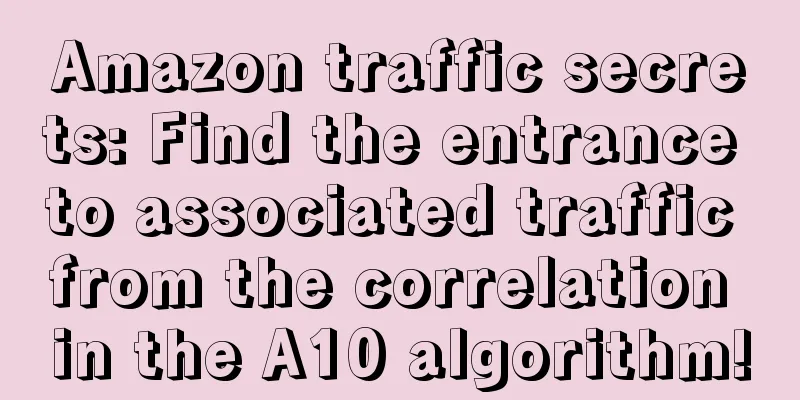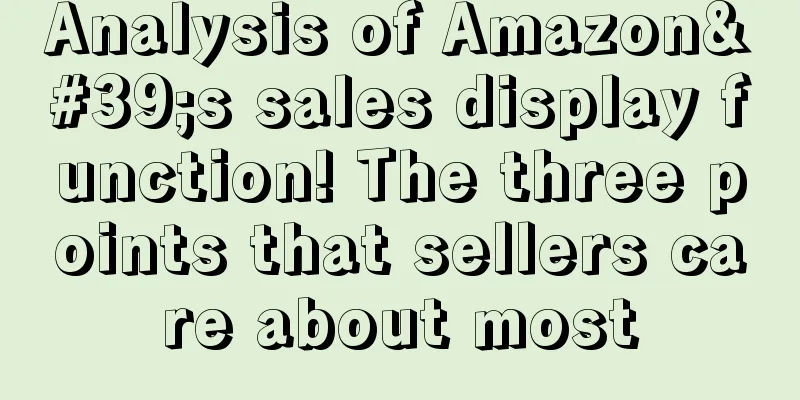Amazon traffic secrets: Find the entrance to associated traffic from the correlation in the A10 algorithm!

|
How does Amazon's A10 algorithm quickly and accurately present good products that customers want to buy to consumers? When users tell the platform their needs by searching for keywords, the platform will establish a connection between user needs and products and then sort the products. This resulted in the three most core indicators in the A10 algorithm: relevance, conversion rate, and customer retention rate. 1. Relevance Relevance refers to the consistency between search results and users' real purchasing intentions. The A10 algorithm measures this through titles, Bullet Points, product descriptions, brands and manufacturers, categories and subcategories, and Search Terms. For example, our titles should use the most relevant keywords for the product, product descriptions should use long-tail keywords as much as possible, and when uploading products, we should ensure that the products are in the most relevant and smallest category. 2. Conversion rate Conversion rate accounts for a large proportion in Amazon's A10 algorithm. The factors that affect its conversion rate mainly include sales ranking, comments, product pictures and quality, price, etc. Sales volume is the most important ranking factor for Amazon. The sales volume directly affects the ranking of products in search results. The second is the number of reviews and good reviews, which not only directly affect customers' purchasing behavior, but also are the main basis for Amazon to score store weight. As for the pictures and quality of the products, we found that larger and higher-quality pictures ultimately lead to higher conversion rates than multiple pictures of normal size. There is also pricing. On Amazon, the cheaper your product is, the better it will sell. The appropriate pricing strategy is also an important factor affecting conversion. In general, when your product conversion rate is high, the A10 algorithm system will think that your product is of high quality and will give priority to displaying your product. 3. Customer Retention Rate Customer retention rate is a score of the seller's overall performance, which includes five aspects: order processing speed, available inventory, perfect order rate, order defect rate and exit rate. Amazon knows that one of the best ways to keep buyers happy is to ship quickly and accurately, so sellers who consistently demonstrate efficient order processing will rank higher than those who don’t. ② Amazon found that lower available inventory may have higher refund and cancellation rates, which is not conducive to retaining buyers; ③ Perfect Order Rate is a measure of how many orders are processed perfectly, from the time the buyer clicks on the product listing to the time the product is added to the card and then to the time the product arrives in the buyer's hands; ④ The order defect rate is the opposite of the order perfection rate. It means that the seller did not provide the buyer with a good shopping experience during the order completion process. The lower the order defect rate, the better. If it is too high, it will not only cause customer loss, but also may be punished by the platform. ⑤Usually a high exit rate is because your product inventory rate is low or the listing is incomplete, etc. The above are the important factors that affect the A10 algorithm. After understanding them clearly, we will know how the platform allocates traffic within the site and how sellers can obtain traffic. However, Amazon is a commercial platform, and its profit model is commission-based. Therefore, its main purpose is to convert the traffic it attracts within the platform. What if this listing cannot complete the conversion? The platform will guide the traffic to continue to flow until the conversion is completed. In this way, each listing not only receives the upstream traffic, but also is responsible for continuing to guide the traffic downstream in order to make full use of the traffic. Understanding this logic also leads to the key point we will talk about next - associated traffic. In fact, associated traffic is easy to understand. It means that when customers search and browse other people's products, they can also see the relevant information of our products. Associated traffic is divided into free associated traffic and paid associated traffic. Where are their entrances on the platform? Please continue reading. The display positions for free associated traffic are divided into three parts: frequently bought together, inspired by your recent shopping trends, and compare with similar items below the listing. Free associations are natural associations. For example, after a buyer buys product A, he or she may also buy product B. The more buyers participate in the purchase, the larger the cardinality of the data model, and the higher the degree of natural association between the two products will be determined by the system. When A and B are often purchased together, the data will be matched with the first frequently bought together. When A and B are not purchased at the same time, for example, a customer buys A first and then buys B after a while, the associated traffic formed at this time is inspired by your recent shopping trends, that is, buy again and again. When compare with similar items, when product B is very similar to product A, the platform will naturally associate and display them. Paid associated traffic is mainly divided into two parts, one is the associated advertising space above the listing details page, and the other is the paid associated advertising space below the listing. It is worth mentioning that the number of associated display slots under each listing is different. The more traffic a listing has, the more listings it will naturally attract. When it comes to paid associated traffic, we have to talk about Amazon’s automatic advertising. Automatic advertising is actually the best way to promote associated traffic matching and open associated traffic entrances, but many sellers don’t realize this. Many sellers do not know how the ASIN code from automatic advertising is generated. In fact, it is when a user searches for keywords and enters the listing page of product A, and then clicks on the advertisement of product B at the bottom of the page, thus reaching the details page of product B. In this way, the ASIN code of product A will appear in the customer search report of product B. If this behavior model appears in multiple buyers and there is a purchase phenomenon, the correlation between product A and product B will gradually increase, and product B may even appear in the frequently bought together module of product A. At this time, the paid association becomes a free association, and the correlation between products becomes higher and higher. Automatic advertising plays a very important role in associated traffic. For sellers, traffic belongs to the platform. If they want to grab more traffic among many competitions, they need to open one associated traffic entrance after another. The more traffic the listing has, the higher the sales volume will be. We have also found the entrance to Amazon's associated traffic. Finally, let's briefly talk about how to obtain associated traffic. There are two aspects: associating with yourself and associating with the products of similar competitors. ① You can associate yourself with yourself. You can use a low-priced and high-traffic product to drive your other high-priced and profitable products or regular and slow-selling products; Sellers with more listing links can use their own products as the advertising space below their product details, forming a closed traffic loop. Then, even if buyers do not buy this product, when they click on other products, they are still their products. Therefore, our products should be relatively refined and of better listing quality. If they are superior to the benchmark ASIN in many aspects, the chances of achieving conversion will be greatly increased. Today I would like to share with you Amazon key product promotion steps and promotion budget table |
>>: Amazon sellers need to be careful of "phishing" emails!
Recommend
Amazon offers $50 advertising coupons for a long time. How can sellers claim them quickly?
Just after Black Friday and Cyber Monday, Amazon...
Amazon CPC surges 45%! Sellers: Losing so much that they doubt their lives!
Speaking of advertising Sellers have a love-hate r...
What is Skubana? Skubana Review
Skubana is an Amazon operation tool. SKUbana can h...
What is Huayue International? Huayue International Review
Huayue International (Shenzhen Huayue Internationa...
Lay off all employees, another cross-border giant officially announces closure
In recent years, foreign trade factories have fac...
In 2023, many US retail giants will go bankrupt. Who can fill the market gap?
It is learned that since 2023, many US retail gian...
CPSC recalls 20,800 Giant bicycles due to loose handlebars, posing a risk of falling!
It is learned that on January 12, CPSC announced t...
GMV target doubled, the four overseas dragons competed fiercely with Amazon!
With the arrival of the first financial reporting ...
What is AMZ Insight? AMZ Insight Review
AMZ Insight can track the performance of organic s...
CPSC recalls this baby product! Available on Amazon!
<span data-shimo-docs="[[20,"获悉,据外媒报道,1月19...
A plug-in to find off-site dynamics of competitors?
https://asin.xuggest.com/ This tool is good, you c...
A surprise on the first day of Black Friday sales? Temu is giving away benefits without limits?
Click on the blue words Follow us The Black Frida...
Survival is not easy! A well-known export supplier in Shenzhen announced its dissolution, and the former large factory with 10,000 employees collapsed!
This year is extremely cold, and how to survive ha...
(Operational Tips) Amazon keywords on the home page
“ More than 80% of Amazon customers shop through ...
After five overseas expansions, Kuaishou has found its “second curve” in commercialization
On January 28, the 2023 Kwai for Business Annual A...









